HANDLOOM WEAVING

In ancient times, the Lepcha’s of Sikkim were said to use yarn spun out of stinging nettle (sisnu) plant to weave clothes.Today cotton and woollen yarn are used together with vegetable dyes and synthetic colours.
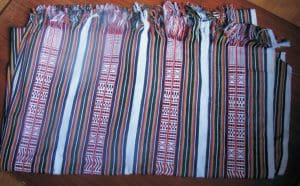

Lepcha weaves or ‘thara’ is woven in vertical looms with a backstrap. Such looms are of small width. Traditional design with different colours are used to make tharas which are used for making bedspreads, bags, belts, curtains, cushion covers, table mats, tray cloths etc, apart from their traditional dress.
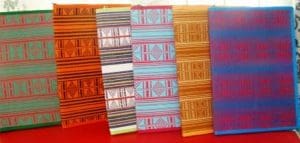

Lepcha women folk work on traditional back-strap loin- looms that enhances the quality of the fabric. The vertical frame loom with a back strap used by the Lepcha women is indigenous in Sikkim. The weave frame is made from bamboo or various types of wood which is available. Nearly all types of weaves can be woven in the loin loom. On a loin loom, the possibilities of weaving pattern are unlimited. The cloth woven by the women is used for women’s traditional coat material. Cotton yarn is the basic material where as the woolen yarn is utilized for the motifs over the coat. The raw material used by the Lepchas for their garments is cotton, and for blankets they use sheep wool. Lepchas rear their own sheep for the wool and some wool is also bought from local traders. The yarn is dyed and dried for at least a week before being put on loom for weaving. Both vegetable dyes and synthetic colour are used in dyeing. The colours are mainly white, black, red, yellow and green etc. The handloom products are ranged from plain to intricate patterns. Traditionally sheep wool was used, but with the intervention of the Directorate of Handlooms and Handicrafts now cotton and acrylic is also being used. Therefore, attractive colour combination and designs can be made today.
Tribes of Sikkim
- Lepcha
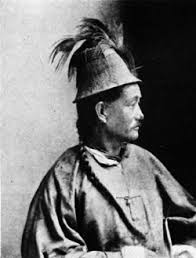
Lepchas are a Mongoloid community living in Sikkim, Darjeeling, Southwest Bhutan and Eastern Nepal. They call themselves Rong from the Lepcha words Rongkup or Rumkup meaning the children of snowy peak/ the children of God. Tradition has it that their creator God, Itbumu, created their progenitors Fudongthing and Nazongnyu from the pure virgin snows of Mt. Kanchenjunga. The couple was instructed to live like siblings but they violated the rules and gave birth to several children. Itbumu is believed to have summoned the two and said, ‘You have committed a sin. I cannot allow you two to live in this sacred mountain any longer. As a punishment, both of you now must live at the foothills of Mt Kanchenjunga as humans and fend for yourselves’ (Aachulay magazine). In the meantime, the abandoned babies grew up to be evil spirits and started troubling the people. After getting rid of seven children, the couple decided to keep their child who is now considered to be the first Lepcha. With their legends pointing Kanchenjunga as the place of origin, it is only understandable to find Lepchas living in the foothills of this mountain for a long time. They have no migration history although some scholars speculate their coming from the east. J.C. White, the first Political Officer of Sikkim.
2.Bhutia (including Chumbisa, Dopthapa, Dukpa, Kagatay, Sherpa, Tibetan, Tromopa. 
Bhutia Places they inhabit :Bhutia tribes are of the Tibetan origin. They migrated to Sikkim around 16th century. In the northern part of the Sikkim where they are the major inhabitants, they are known as the Lachenpas and Lachungpas. Majority of the Bhutias are concentrated in the dry valley of the north Sikkim.
Language and Costumes:Bhutia tribes usually speak Sikkimese. Apart from that they also speak Lepcha, Bhutia, Nepali, English and Hindi. Bhutia male wear Bakhu which is a loose traditional dress with the full sleeves. While the women dress consists of Silken Honju, which is the full sleeves blouse and a loose gown type garment. Female also prefer wearing jewellery of pure Gold.
Population and Occupation :Bhutias forms 14% of the total population of Sikkim. They are extremely warm hearted and simple people. They prefer living in the joint families. A Bhutia house called Khin is usually built in the rectangular shape . Most Bhutia follow tantric Buddhism. The legal system among the Bhutias is termed as the Dzumsa, which means the rendezvous point of the common masses. Dzumsa is headed by Pipon who is the village headsmen. It ensured law and order and is responsible for conservation practises such as grazing, cultivation programs and the seasonal development of the community. Agriculture is the main source of occupation among the Bhutias. While some of them are also herdsmen and the breeder of sheep and yaks.
Cuisine :Bhutias usually prefer rice with the animal fat. They are common beef eaters. Some of their traditional costumes include Momos, Gya Thuk, Ningro with Churpi, Sidra Ko Achar, Saelroti, Shimi Ko Achar, Pakku, Kodo Ko Roti, Phapar Ko Roti, Silam Ko Achar, Phulaurah Gundruk, Phagshapa, Sael Roti. They are also fond of Chaang (the millet bear). It is served in the special bamboo container called Tongba with the hollow pipe made of Bamboo.
Festivals :Losar and Losoong are the main festivals celebrated among the Bhutia tribes. Losar falls in the first week of the February. It marks the beginning of the Tibetan New Year. The act of Fire Metho takes place in the evening. Losoong marks the end of the harvest season and also the end of the Tibetan year. It falls in the end of the tenth Tibetan lunar month (in December). It is among the most important festival among the Bhutia tribes in India. Chaan dancings and merrymaking at the monasteries at Palace (Tsuklakhang), Phondong and Rumtek. Archery competition is the main attraction of the festival. They make offerings to the God and exchange feasts among each other. Stage fights and passing through the crowds with the fire torches add more excitement to the festival.
3.Limbu (Subba)
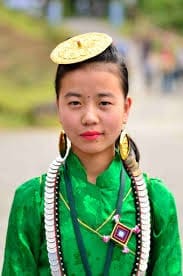
The unification of Limbuwan kingdoms and Nepal has brought changed on Yakthungs(Limbu) as their Hindu caste system given them name to all those living in Limbuwan as Limbu, Subba and ranked them as one of the unenslavable alcohol consuming groups (namasine matwali jaat). After their land by loss of gorkhaland, the Limbus have divided into three nationality Nepalese Limbu, bhutanese limbu and Indian Limbu.
The Limbu nation is made up of hundreds of clans. Each Limbu clans are classified under their Tribe or subnational entity or according to their place of origin. Almost all the Limbu clan names are unique, therefore it is not necessary to specify the Tribe or the place of origin every time the clan name is said.
The most Limbu (Yakthung) tribes are the original inhabitants and descended from the ancient Kirata mentioned in such Hindu epics as the Mahabharata, other thirteen clans of Limbus originated from Lhasa ghotra and Khasi gotra.
4.Tamang
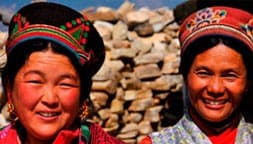
Tamang make up the largest indigenous peoples among the 59 so far recognized by Nepal government. The term Tamang is made up of two words—Ta which means horse and Mang, which means rider or trader. It is assumed that they were connected with business of horse trading or riding. They have their own distinct religion, language, culture, customs, rituals and lifestyles. They say that they are the original people of Yambu, the Kathmandu valley and there are settlements of Tamang around Yambu even today. But the large number of Tamang community lives in at adjoining districts of Kathmandu valley namely—Rasuwa, Makawanpur, Nuwakot, Dhading, Kavrepalanchowk, Sindhupalchowk, Dolakha and Sindhuli, in the middle hilly region to the Himalayan range of Nepal including in Kathmandu valley. However they are now spread all over the country, and beyond Nepal, they are especially found in large numbers in Darjeling, Sikkim, Asam and Nagaland of India and in Burma and Bhutan. According to the latest national census 2011, their population stands around 1,539,830, which is about 6 percent of the total population of the country. Besides, Nepal an estimation puts that approximately 2 million Tamang live in different parts of India, Bhutan and Burma.
Tamang are very rich in their tradition and culture. They have their own language, culture, dress and social structure. They have over 100 sub-clans. Tamang believe in Buddhism, and famously said that 90 percent of Tamang follow Buddhism as their religion. Their language comes from Tibeto-Burman language family. They follow the Tibetan calendar of the 12-year cycle and their typical song-dance Bhote-selo literally means ‘Tibetan tune’, which is famously known as Tamang selo, which include the songs of humor and wit, satire, joy and sorrow. Tamangs have their own music. Their musical instrument is called Damphu (a small round drum covered with goat skin).
- Lepcha and Bhutia are also included under a special category known as the BL(Bhutia-Lepcha) Group which is quite different from the Tribal Status but it is a constitutional right safeguarding the interest of the two ethnic groups of the state
Sikkim Culture
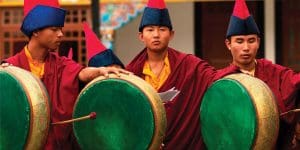
Sikkim is a beautiful land of manifold tribes and races of people living together. All these diverse tribes and communities have their unique features in addition to their particular dance forms, festivals, languages, culture, and craft forms. The miscellany of ethnic groups, religion, and languages is seen all over Sikkim.
Sikkim Languages Nepali is the primary language of Sikkim while Lepcha and Sikkimese (Bhutia) are also spoken in some part of this north-east province. English is also spoken by the people of Sikkim. Other languages include Kafle, Limbu, Majhwar, Yakha, Tamang, Tibetan, and Sherpa.
Sikkim Festivals
Fairs & festivals of Sikkim
Sikkim is a state in northeast Asia where numerous festivals are celebrated throughout the year. Majority of the people of Sikkim follow Buddhism so the festival celebrated here are associated with the Buddhist and they are celebrated with a lot of pomp and as per the Buddhist calendar.
In Gompas or Monasteries of Sikkim, most of the festivals are celebrated where people gather together in order to celebrate the occasion. During these festivals, the citizen of Sikkim involves in vibrant and lively dances and music.
The most fascinating form of ritual dance that is performed by the Lamas is “Chaam” which involves colorful masks and amazing musical instruments. Lamas dressed with blithely painted masks, ceremonials swords, sparkling jewels, and dance on the rhythm of the music, drums, and horns. Some of the most popular festivals, notable in Sikkim are as follows:
Saga Dawa:

A triple favored celebration, Saga Dawa is reckoned as one of the godliest festivals in Sikkim especially for the Mahayana Buddhists. On this particular day, the Buddhists visit the monasteries, offer the prayers and butter lamps as they were the three remarkable events associated with the existence of Buddha which is celebrated at this event. This particular is held on the full moon of the 4th month of the Buddhist calendar either at the end of May or at the beginning of June. This festival takes place in Gangtok.
Lhabab Dunchen Festival:
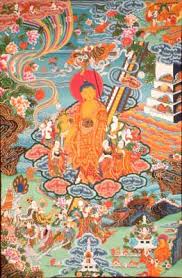
This festival represents the descent of Lord Buddha from the heaven. Lha means “Heaven” and bab means “Descent”. Thus, this festival celebrates Lord Buddha’s descent from deva kingdom after teaching his departed mother, Mahamaya. This festival takes place on the 22nd day of the 9th lunar month every year.
Losar Festival:
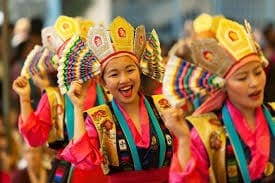
Losar is Tibetan New Year festival and is marked with a lot of festivities, gaiety, merrymaking, and feasting. This festival usually celebrated in the first week of February.
Drupka Teshi Festival:
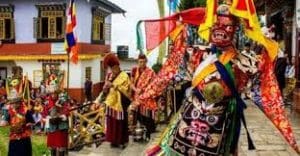
Another amazing festival celebrated by the Buddhist is the Drupka Teshi Festival. Falls on the fourth day of sixth Tibetan month, around the month of August, this festival is celebrated with full excitement as on this day the Buddha lectured his first sermon of four Noble Truths to his five disciples in Sarnath at the very famous deer park.
Phang Lhabsol:
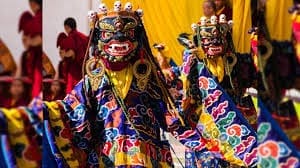
Phang Lhabsol is one of the most unique festivals of Sikkim, wad made renowned by ChakdorNamgyal, the 3rd ruler of Sikkim. This festival involves worshipping Mount Kanchendzonga and devoting for its uniting powers.
Bumchu Festival:
The festival of Bumchu is celebrated with full grandeur and zeal at the Tashiding Monastery in the West Sikkim in the month of January. Bum represents “pot or vase” and chu means “water”. During the celebration, the pot that is filled with the Holy water is opened by the Lamas present in the monastery.
A part of the heavenly water is then distributed to all the devotees who are gathered in this festival. And then, the pot is refilled again with water and sealed for the next year’s celebration since the level of the water in the pot depicts the prosperity of the future year.
Losoong Festival
Another great festival of Sikkim, Losoong Festival is celebrated on the occasion of the end of the harvest season and at the end of the tenth month of Tibetan year in the rural Sikkim. During this festival, the Chaam dances by the people of Sikkim are performed. All these festivals take place at the Tsu-La-Khang monastery, Phodong monastery, and Rumtek monastery.
Dasain Festival:
It is the main festival of Hindu Nepalese in Sikkim which takes place a few weeks before the Losoong Festival. The celebration of this festival signifies the victory of good over evil. The elder people of the family apply “Tika” to younger people and give them their blessings.
Tihaar Festival:
The Tihaar Festival is another exciting festival of Sikkim that is celebrated as the festival of lights which is somewhat like Diwali.
Hee Bermiok Tourism Festival:
Hee Bermiok is an annual festival which is celebrated in Hee Bermiok city. This city is located nearby Gangtok. This festival started in 2005 and the uncountable number of people comes to this beautiful city to join this amazing carnival. The festival takes place in the month of May every year.
Music & Dances of Sikkim:

Dance & music of Sikkim, culture of Sikkim Folk songs and dances are an inveterate part of the Sikkimese culture. Most of the tribal dances depict the harvest season and they are performed for prosperity. The dances of Sikkim are accompanied by traditional musical instruments, chanting, and the dancers carry bright costumes and traditional masks. Some of the most famous dance forms are Rechungma, Gha To Kito, Chi Rmu, Be Yu Mista, Tashi Zaldha, Enchey Chaam, Lu Khangthamo, Gnungmala Gnunghey, and Kagyed Dance.
People of Sikkim
The people of Sikkim are warm, simple and friendly with a nature gaiety. In general, they are known as Sikkimese. But Sikkim is a state of diverse communities, cultures, religions and customs. Sikkim has a good mechanism of living harmony in between people of the states. It is a good example of Indian “Unity in Diversity”. There are three main communities in Sikkim – Lepchas, Bhutias and Nepalese.
And also many people are migrant to Sikkim, from overall India (likely Marwaris, Biharis, Bengalis, South Indians, Punjabis, etc) and Nepal. They are mainly settled on the municipal areas of Sikkim, owing to their businesses and Government services. The developmental activities in Sikkim like construction of roads, bridges, buildings etc, have informally invited migrant laborers from the plains and Nepal. A few thousand Tibetan Refugees are there who settled well in Sikkim.
There are brief discussions about three main communities of Sikkim:
The Lepchas
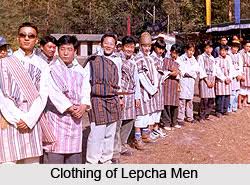
The Lepchas were said to be the original inhabitants of Sikkim the migration of Bhutias and Nepalese. The word “Lepcha” means the ravine folk. They were believed in the bone faith or mune faith based on the spirits, good and bad. They used to worship spirits of mountains, rivers and forests like any other tribes. Perhaps, this could be the reason why these people prefer to live in the healthy natural world. The Lepcha (Zongu) folklore is rich with stories. Nowadays they are mainly adopting Buddhism or Christianity. Near about 10 to 14 percent of the population of Sikkim are belongs in this communities. The Lepchas are concentrated in the central part of Sikkim. This area are encompasses the confluence of Lachen and Lachung rivers and Dickchu.
The Lepchas speak the language Lepcha, although this language is not very well developed but is rich in vocabulary related to the flora & fauna of Sikkim.
Lifestyle of Lepcha :

The Lepchas have a very simple lifestyle. They are very intelligent and hospitable in their nature. They are peace-loving people who avoid quarrels. They love sports and very good at archery. The polyandry marriages are permitted amongst the Lepchas. They mostly live by business and on agriculture of paddy, cardamom and oranges.

They build a house known as “li”. It has a rectangular shape and 4 to 5 feet height, made by wood or bamboo. A traditionally dressed Lepcha male wear half pajamas, under a robe made of striped cotton resembling a loose jacket- the whole ensemble is called a “pagi”. The Lepcha lady wears a two – piece dress -a full sleeved blouse called “tago” and a skirt called “domdyan”.
The Bhutias

The Bhutias are originally belongs to the Tibetan origin. After the 15th century, these people migrated to Sikkim. Mainly they are settled on the northern part of Sikkim, are known as the Lachenpas and Lachungpas. The Bhutias speak ‘Sikkimese’ language, dialect of the Tibetan language. If compared with the Lepchas, the Bhutias are dominating large number of villages.
Lifestyle of Bhutias :
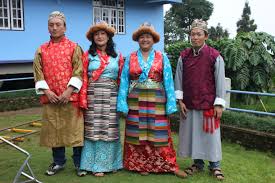
A Bhutia house called “Khin” is usually of rectangular shape. The traditional dress of the male member is known as the “Bakhu” which is a loose cloak type garment with full sleeves. The ladies dress consists of a silken “Honju” which is a full sleeve blouse and a loose gown type garment. The ladies are very fond of heavy jewelry made of pure gold. Sikkim has its religion incorporated with Bhutias. Constituting around 16% of the total population of Sikkim, Bhutias regard priesthood as their academic as well as spiritual choice. The marriage in a Bhutia family is also arranged through negotiations. Before the marriage, the boy’s uncle goes to the girl’s house with gifts to ask for the hand in marriage for his nephew.
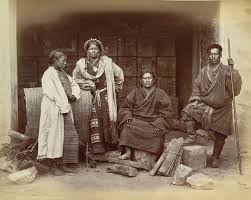
Bhutias usually take rice with animal fat fried vegetables or meat. The other foods are “Momo”(steamed samosa with meat inside) and Thukpa (Noodles). “Zhero” and “Khabzay” are beautiful salty tusks prepared from flour during the festivals like Losar/Loosong.
The Nepalese

The Nepalese appeared on the Sikkim after the Lepchas & Bhutias. They migrated in large numbers and soon became the dominant community. In the present day, the Nepalese constitute 70% of the total population of Sikkim. They introduce commenced terrace farming in the state. Cardamom is an important cash crop that was cultivated by the Nepalese. Except for the Sherpas & Tamangs who are Buddhists, the Nepalis’ are orthodox Hindus with the usual cast system and tribes like Bawans (Brahmans), Chhetries, Gurungs, Tamangs, Rais, Limbus, Magars, Damais, Kamis etc
.These people speak language that is similar to Hindi and is understood throughout the state of Sikkim.
Lifestyle of Nepalese:
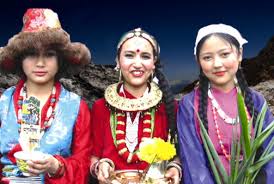
The Nepalese are spread throughout the state. Their style of living is comparatively much economical. Their dresses and diets are simple. They are good farmers and businessmen. Also, they are ahead in education which enables them to get jobs in the Government.
The traditional Nepali dress for males comprises a long double-breasted garment flowing below the waist along with a trouser known as ‘Daura Suruwal’. The traditional dress for females comprises of a double breasted garment known as ‘Chow Bandi Choli’. The shawl wore by them is known as ‘Majetro’. ‘Khukri’ is a heavy weapon that is carried in a wooden or leather case known as “Daab”.
Traditional Attires in Sikkim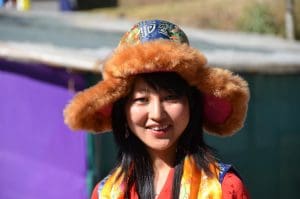
Emerging from the ethnic soil of Sikkim and accentuating its culture is the traditional attire known as Kho, as per Bhutia and Bhaku according to the Nepalese dialect. This attire has a loose appearance almost like a cloak garment which needs to be tightened around the neck area and needs to be belted towards the waist portion. The belt is made of either Cotton or silk in texture and fabric. Men, as well as women, add grace to this outfit by adding more elegance and beauty in their own signature styles.
Origin and History
The traditional attire in Sikkim traces its historical emergence centuries aback when it was ruled by the dynasty of Bhutia Namgyal. It was during his era, that this Sikkim traditional attire was promoted and embraced by the elite classes of the Sikkimese society. This outfit brought status, class, and position among the communities which kept them apart from the rest.
Style
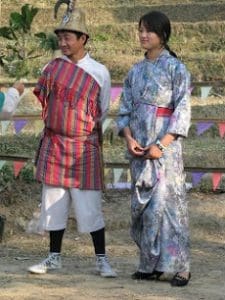
There are different styles according to which men and women of Sikkim wear this traditional attire. For instance, men wear Bakhu with a pair of loose trousers fastened with a leather belt. Women belt this outfit over a silk blouse which is full sleeved, ethnically known as honju. Married women wear this attire in a symbolic way which showcases their marital status as well. This entire robe is called the pangden. Leather boots are also accompanied and preferred with this outfit by women as well as men.
Influences over the years
Previously, a pure traditional attire in Sikkim showcased bakhu which was escorted with cotton or silk belts and leather boots. But over the years, more additions have refined the essence of the outfit in form of a waistcoat popularly known as Jya Jya, shambo which is an embroidered cap and a jacket called Kushen. With these new enhancements, the overall look has become more elegant and poised, while retaining the original crust of the attire.
Innovations
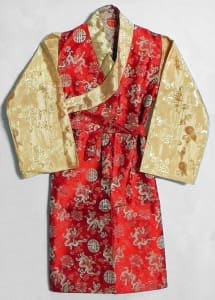
More variations in colors and patterns have enriched the entire look and feel of the traditional attire in Sikkim in the last several years and among today’s trendier generations. Different varieties in blouses like Chaubandi Cholo and Tharo cholo have emerged, which makes the outfit classier. These blouses are intrinsically printed and embroidered with flowery patterns and designs. Urbanized colors have upgraded the entire outlook of the outfit towards advanced fashion levels.
Today’s generation Sikkimese women wear jeans with the bakhu outfit which gives a western twist to the entire tradition. Besides, even shawls that are popularly known as ‘Majetro have been added to the entire attire, which has produced and created fashionable trends and options for people with different tastes in style.
Global Influence
Owing to the comfortable feel of the fabric and its creative finesse, international markets have started to embrace the creativity of design in their own techniques and creations, which has managed to steal the hearts and minds of people all over the world.
The Attire Suitability
To enhance the look of this traditional attire in Sikkim, men generally go in for embroidered hats and boots to compliment the look. Women to complete the attire, accessorize themselves with gold plated neck pieces are known as Lyak , Gyar which are bracelets, pearl ornaments called Diu, Khalli which are thick and silver coated anklets and Namchok which are ethnic and traditional ear drops and rings. It is universally known that Sikkimese women prefer heavy and chunky gold ornaments and jewelry to complete the entire traditional fashion experience.
Traditionally, crediting to the coarse texture of this outfit, men wore this traditional garb while working in forests and fields. But when the outfit was introduced to finer fabrics like Cotton and Silk, it acquired a more stately appeal which made it fit for wedding ceremonies, folk festivals, harvest festivals, religious rituals and other gatherings.
Ornaments
Sikkim Ornament

A Lepcha male wears Thakro, a colourful sheet, Yenthatse (shirt) and a Shambo (cap). The Lepcha female dress comprises of Dumbun (a kind of sheet worn sari style), Tago (loose blouse) , Nyamrek (belt) and Taro (cap). The beautiful ornaments used by the Lepcha women are: Namchok (ear-ring), Lyak (necklace), Gyar (bracelet), etc.

The attire of a Bhutia male consists of Kho (Bakhu), Jya Jya (waist coat), Yenthatse (shirt), Kera (cloth belt) and Shambo (cap). The Bhutia female dresses are: Kho (Bakhu), Hanju (loose blouse), Kushen (jacket), Shambo (cap different in design than used by men), and Shabcha (shoe). Pangden, the striped apron is a symbol of married Bhutia women.
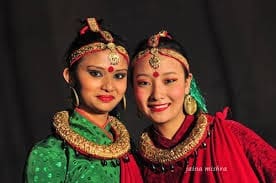

Sikkim OrnamentThe jewellery items used by the Bhutia women are known as Yencho (earring), Khao (necklace), Phiru (pearl ornament), Diu (gold bangle) , and Joko (ring). On the other hand, common Nepalese men wear a shirt known as Daura, while their Churidar Pajama is known as Shurval, the waist coat is known as Aaaskot and their belt is known as Patuki. The colourful sari worn by a Nepali woman is known as Pharia, their long loose blouse tied from four sides is known as Chaubandi Cholo, while another type of popular blouse is known as Tharo Cholo. A piece of printed cloth covering the upper portion of the body is known as Hembari, whereas a colourful piece hanging from the head to waist during a dance performance is known as Pachauri.
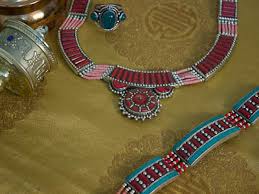
The ornaments used by the Nepalese women are Sir-bandi (tiara), Kantha (necklace), Naugeri (necklace of pearl), Charanihari (another type of necklace), Tilhari (green bead with a long gold pendant worn normally by married women), Bulaki (nose-ring), Dungri (nose-pin), Tik-mala, Chandrahar, Chepti son (ear-ring), Gadwari (ear-ring), Chura of Silver (bracelet) and Kalli, thick heavy payal made of silver.
Article written by bhavika gulrajani B.Sc in Textile and Apparel Designing from Sir Vithaldas Thackersey College of Home Science. Textile Value Chain intern.

